
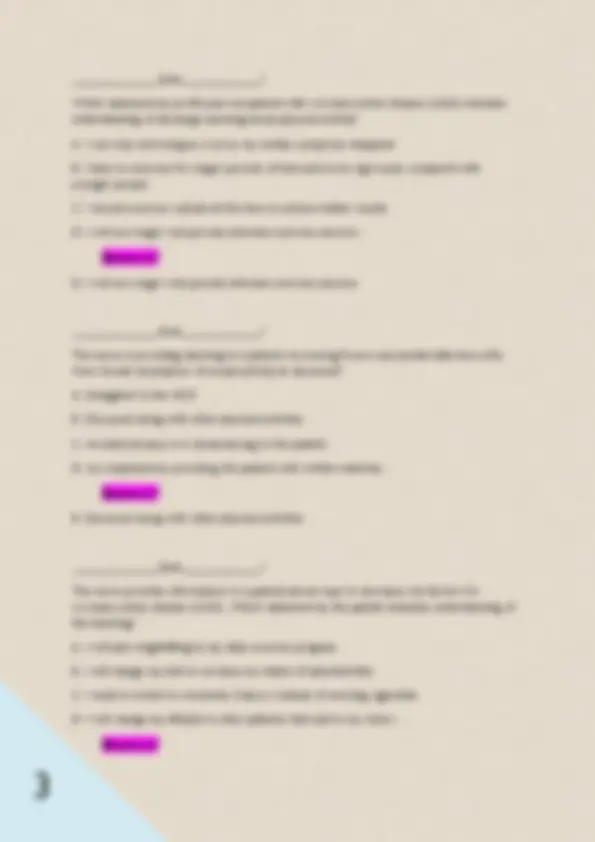
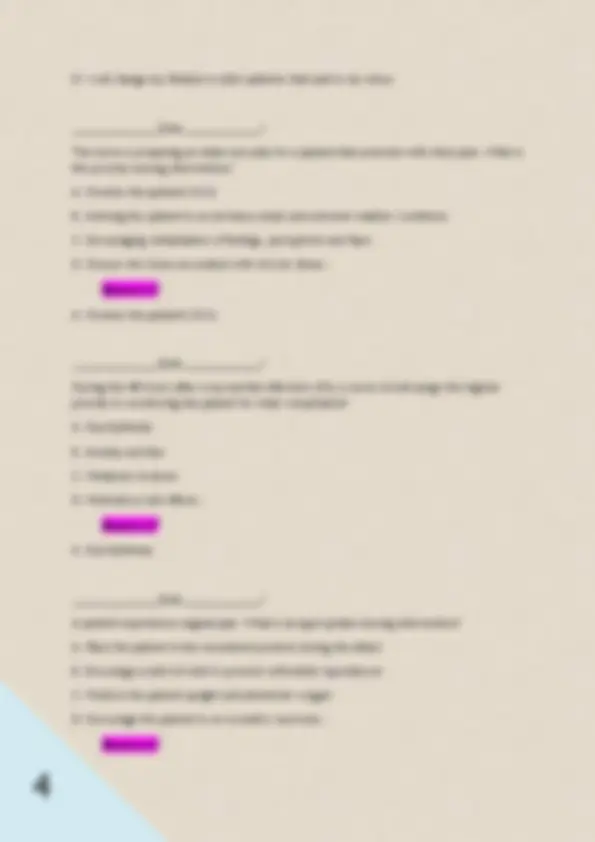
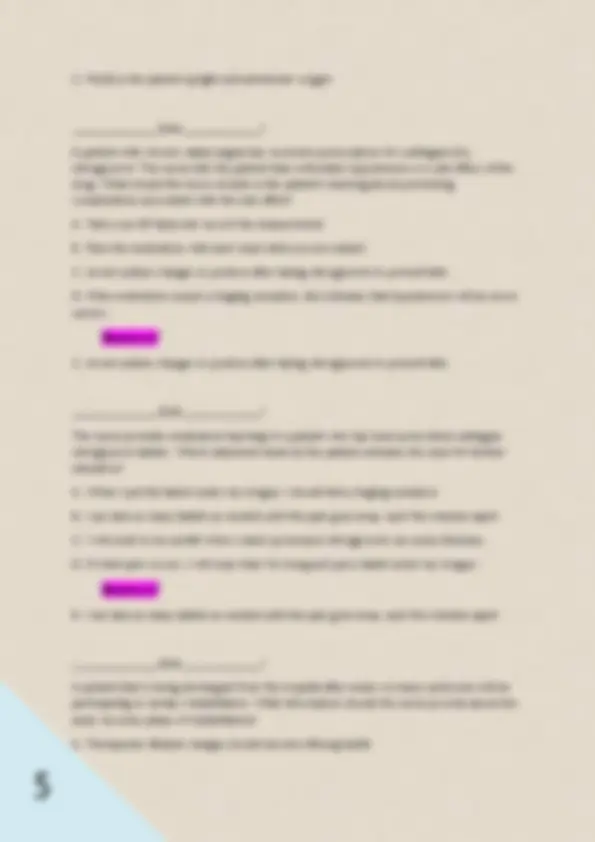
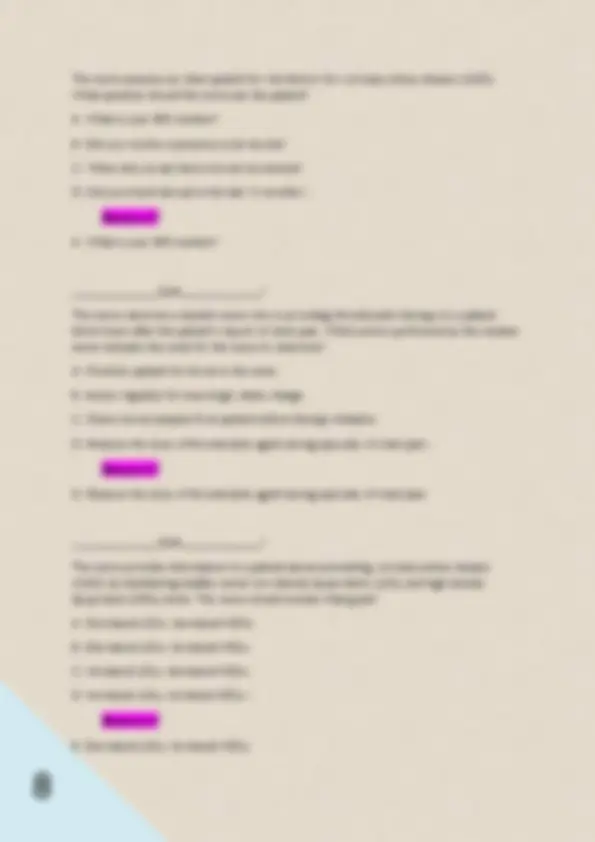
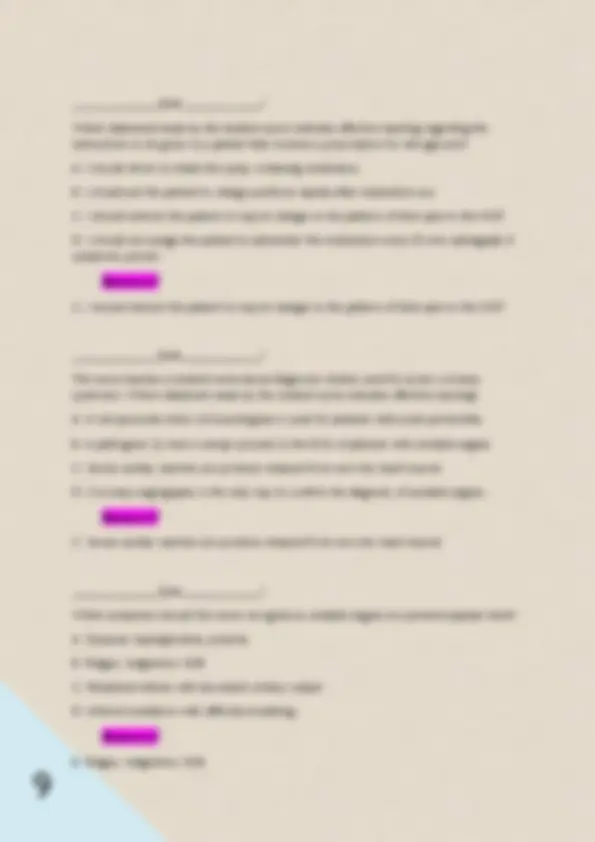
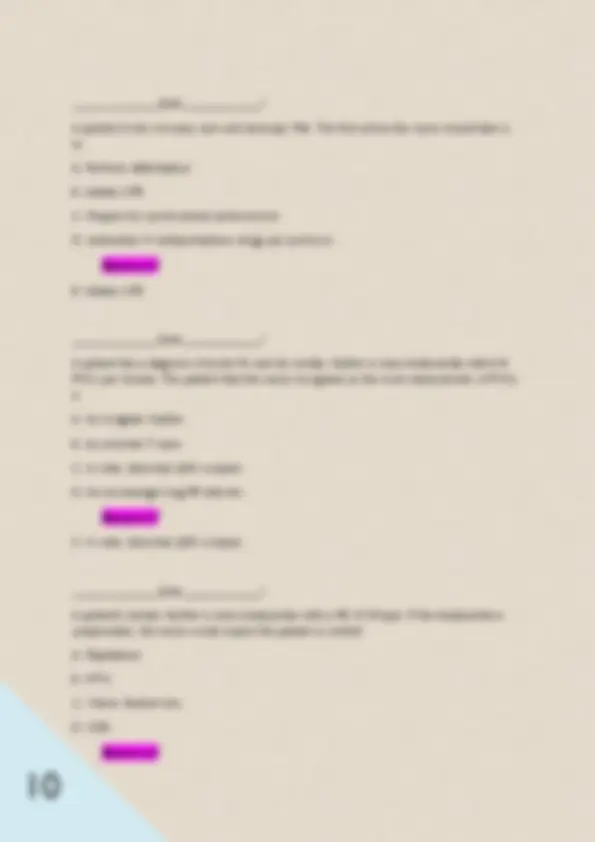
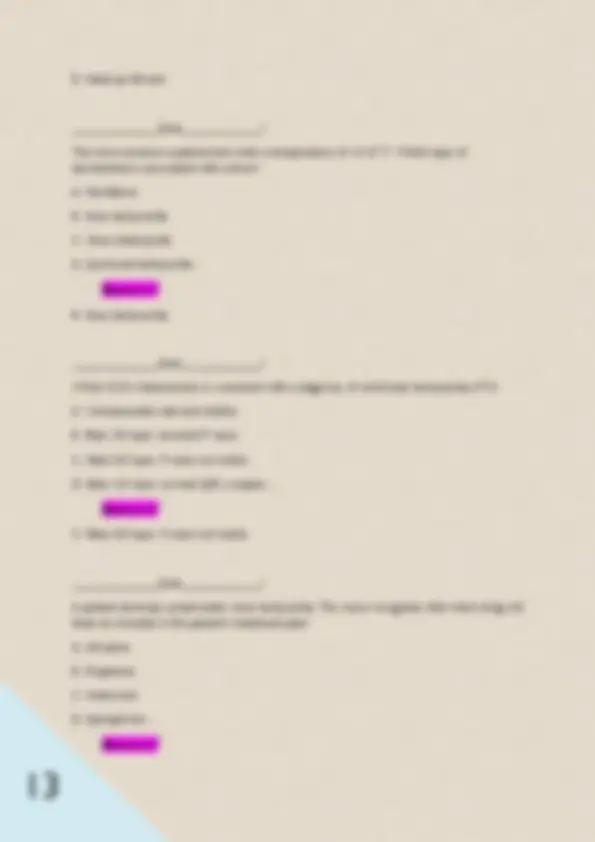
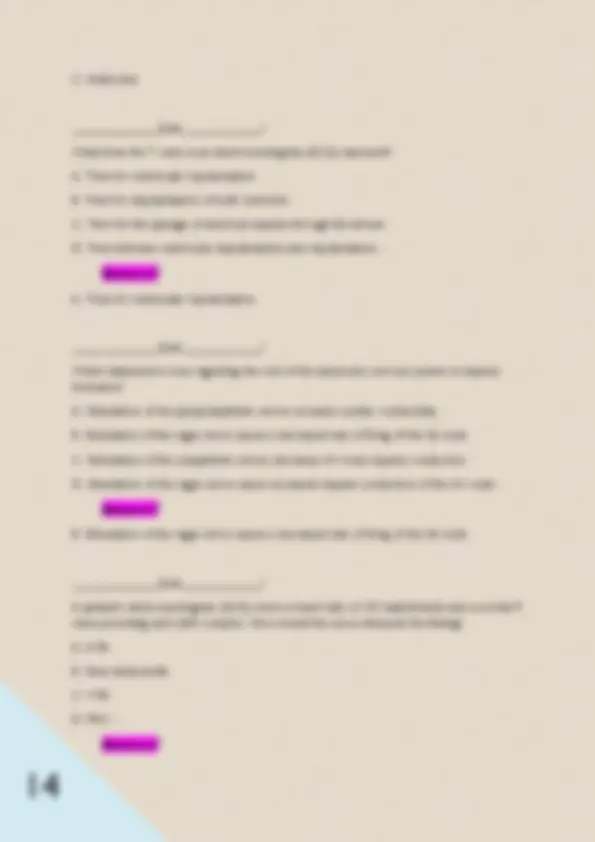
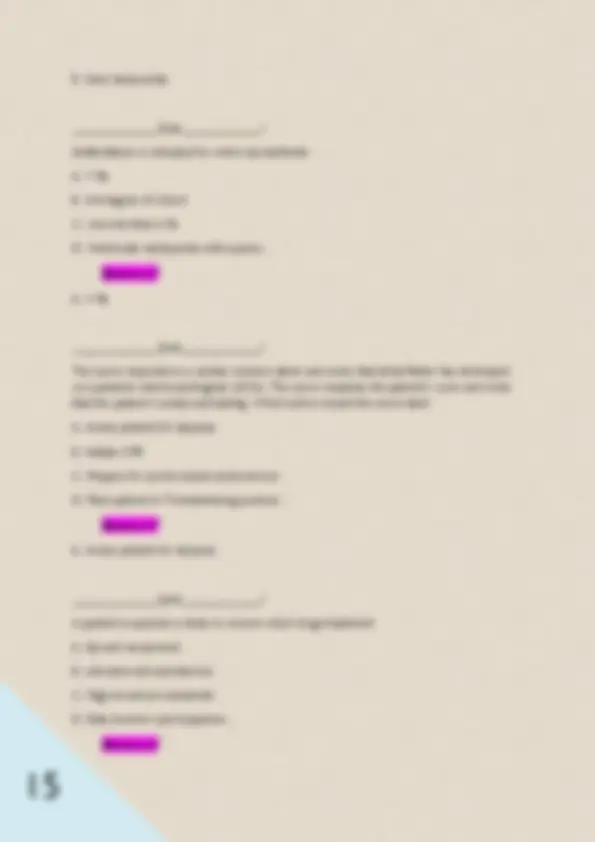
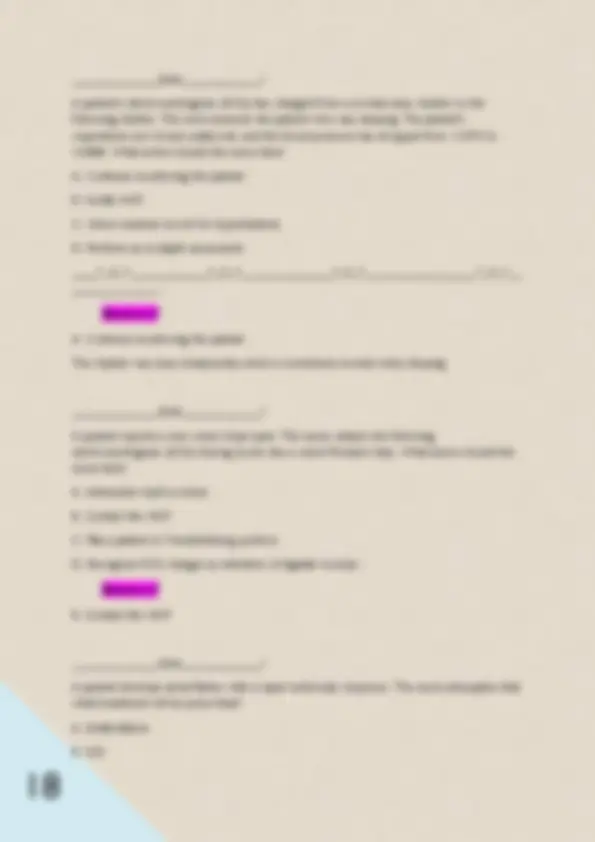
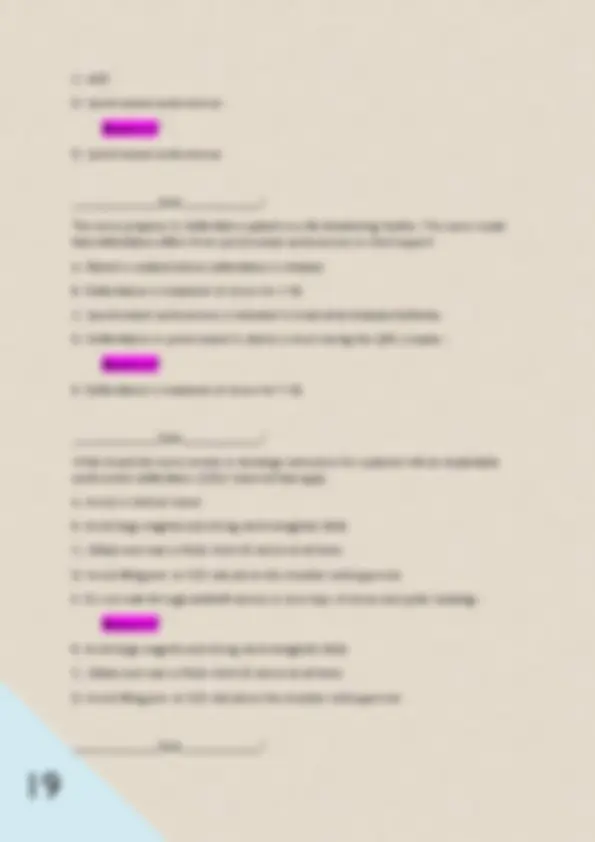
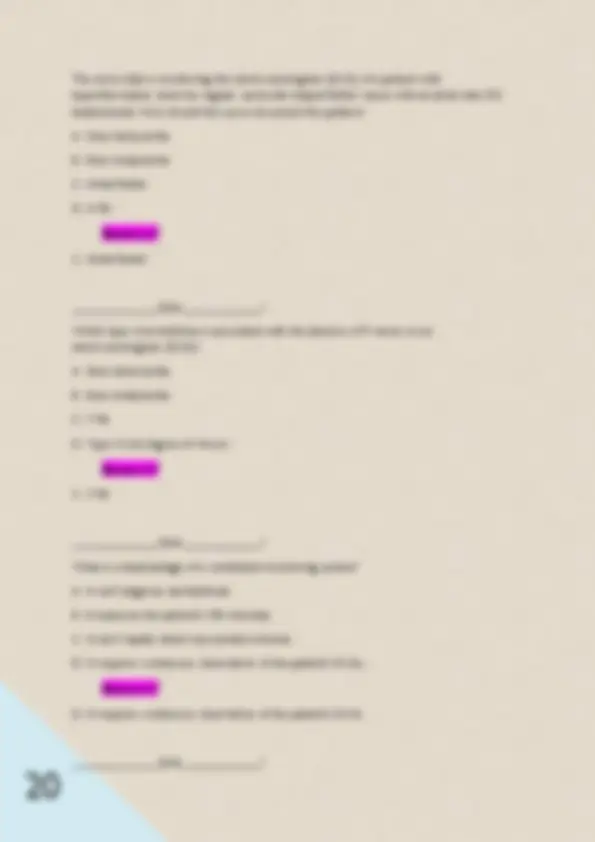
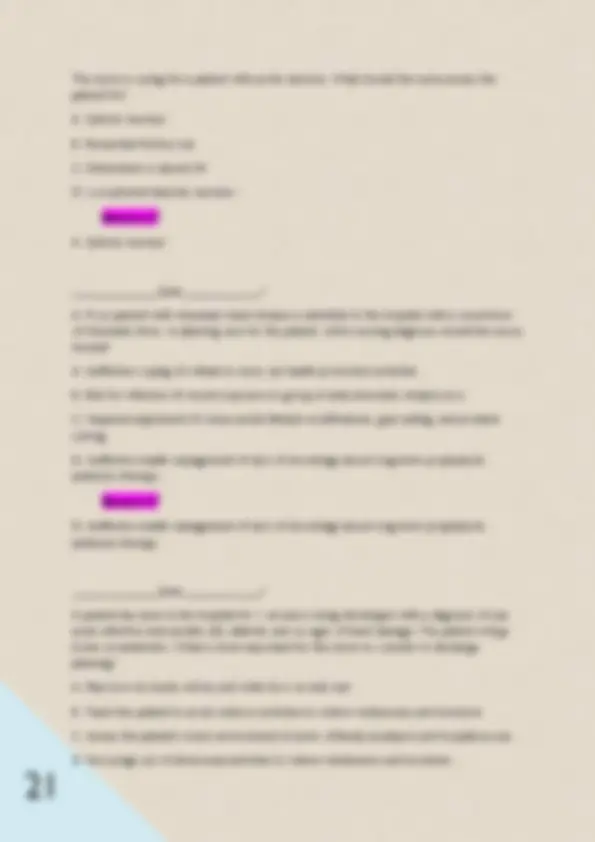
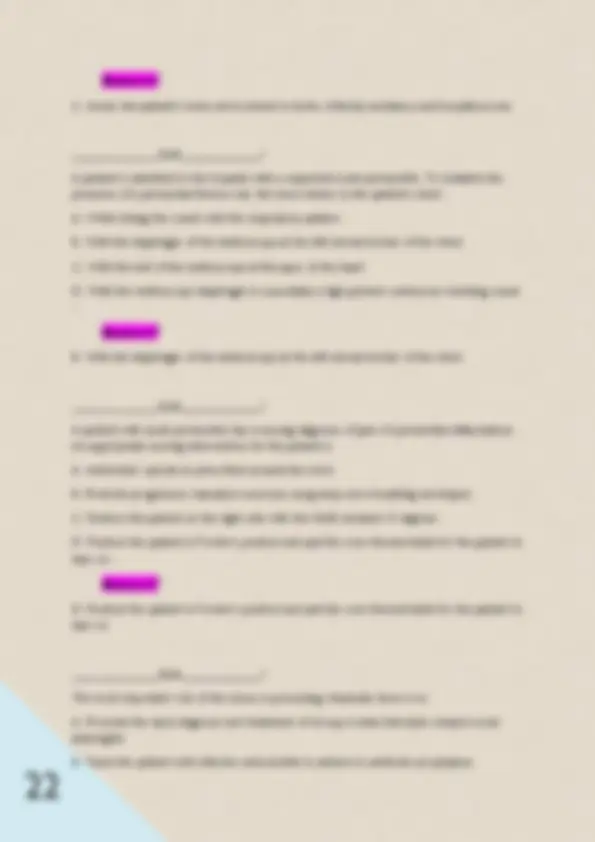
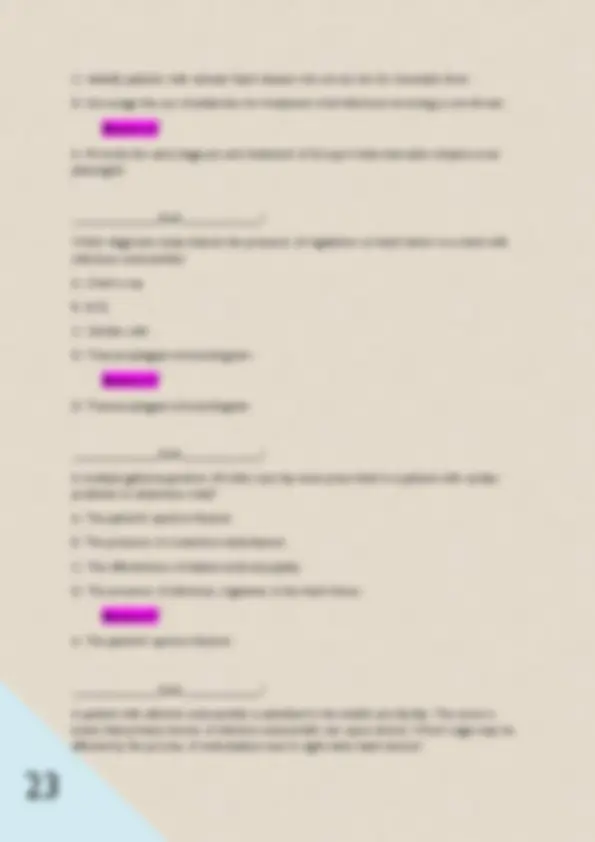
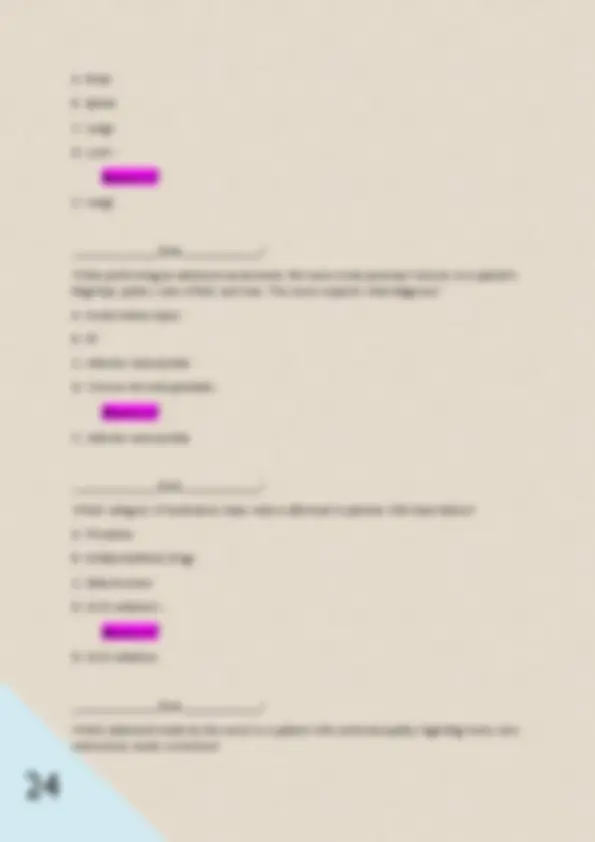
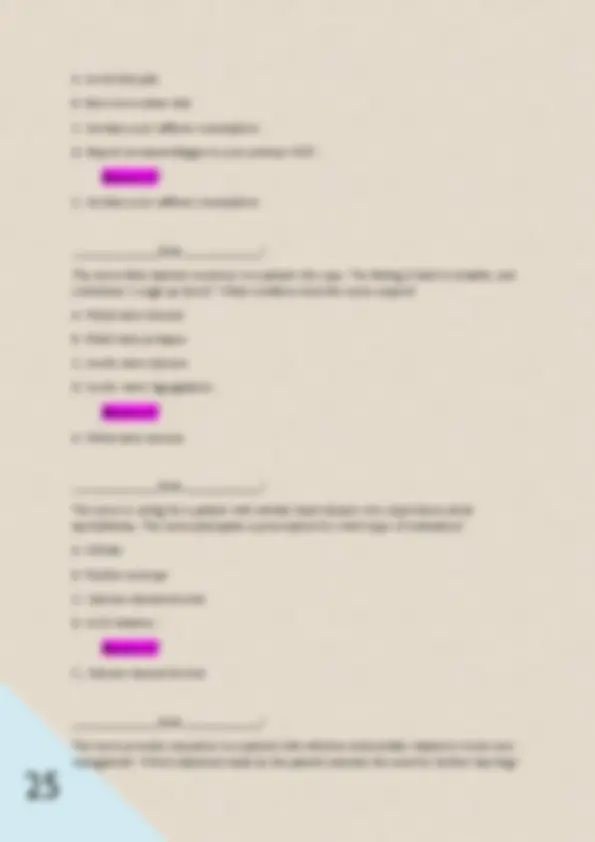
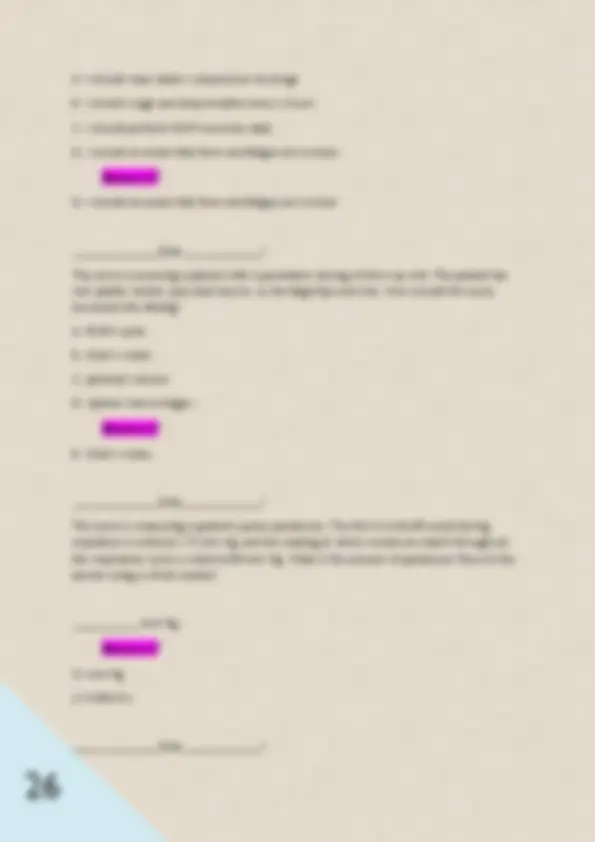
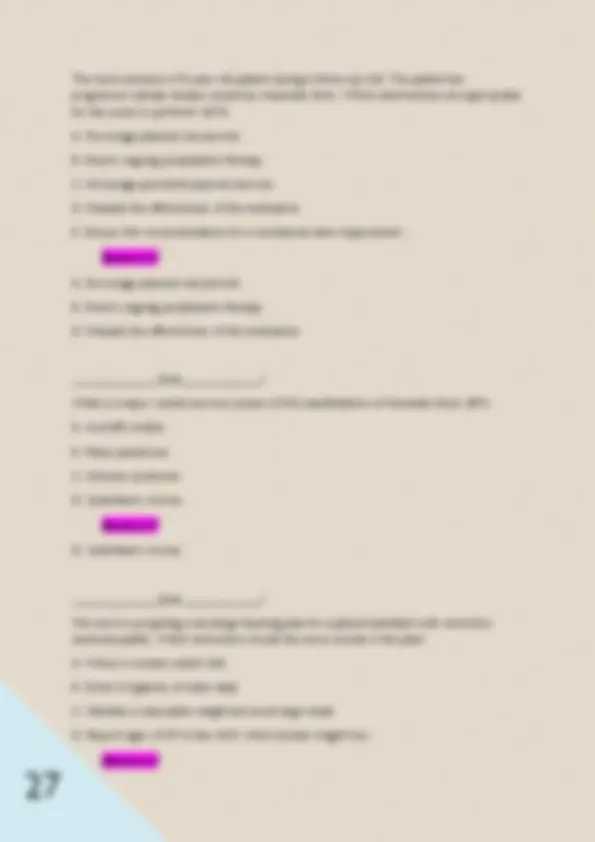
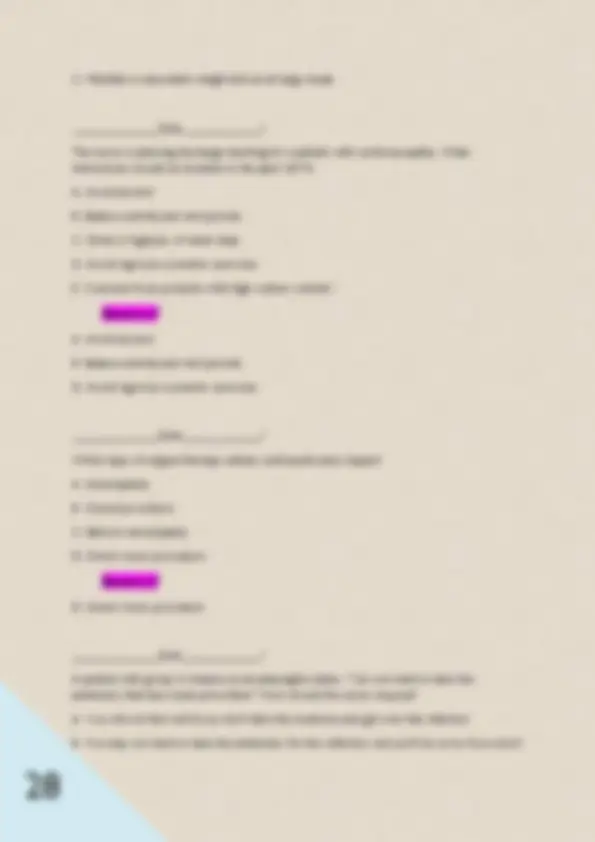
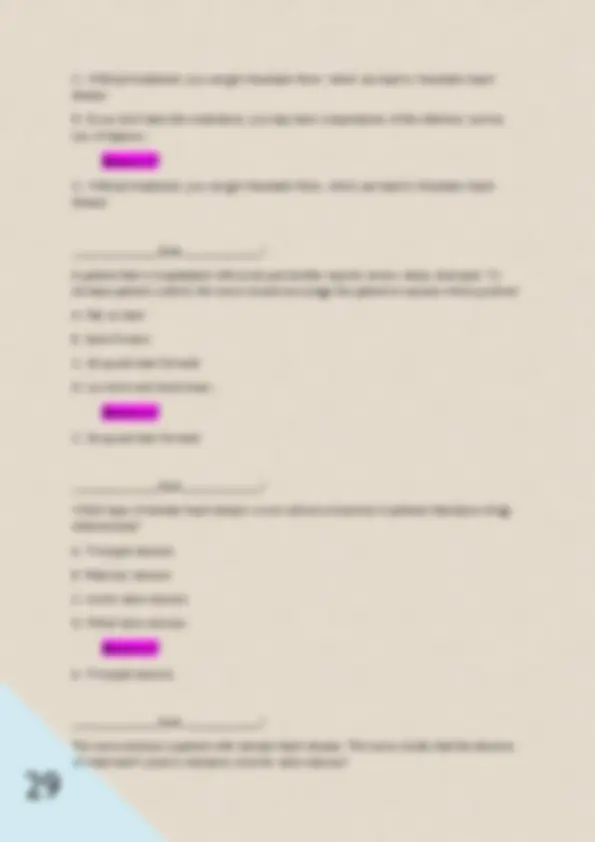
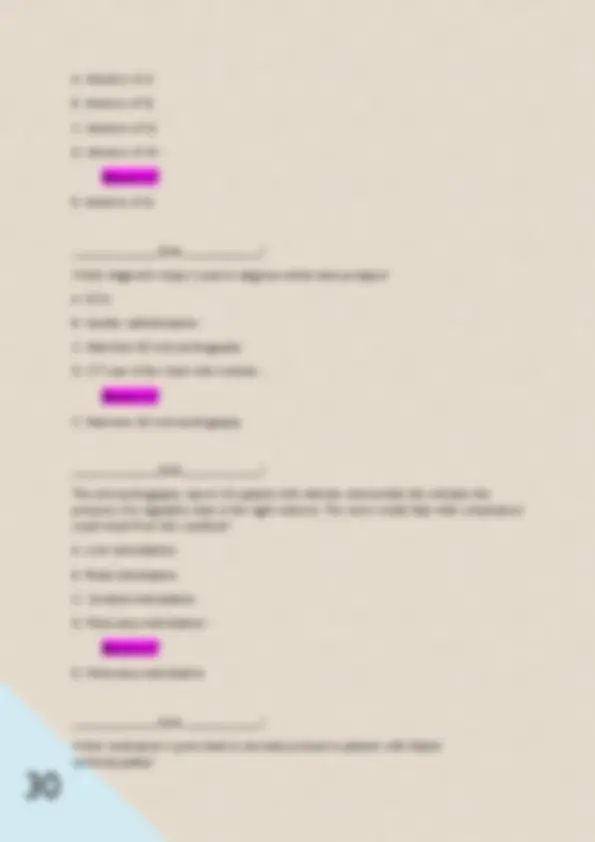
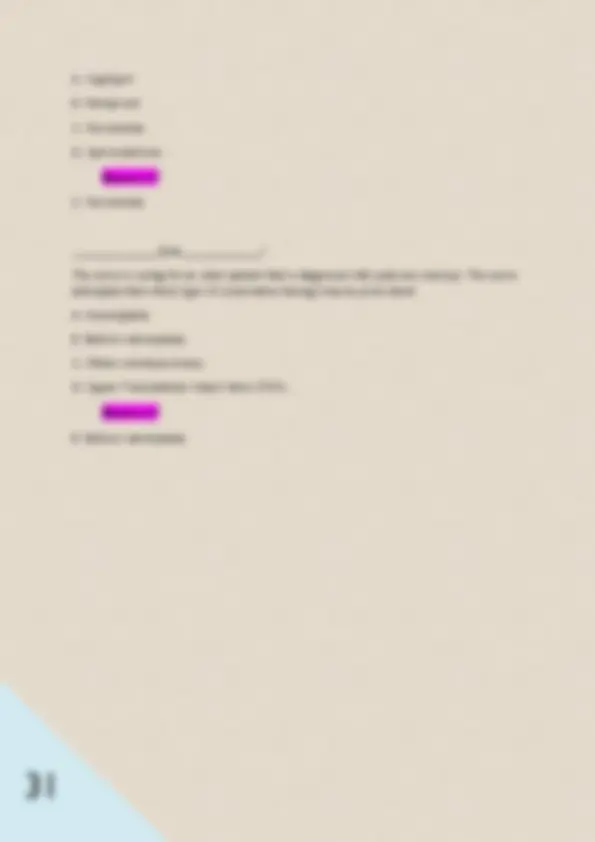


Study with the several resources on Docsity

Earn points by helping other students or get them with a premium plan


Prepare for your exams
Study with the several resources on Docsity

Earn points to download
Earn points by helping other students or get them with a premium plan
Community
Ask the community for help and clear up your study doubts
Discover the best universities in your country according to Docsity users
Free resources
Download our free guides on studying techniques, anxiety management strategies, and thesis advice from Docsity tutors
Med Surg 2 Exam 1 Practice Questions / Study Guide Questions with Definitive Solutions. _____________Quiz____________? A patient who has received a maximum dose of nitroglycerin continues to report chest pain. What is the next medication that the nurse should administer to the patient? A. Ticagrelor B. Morphine sulfate C. Docusate D. Esmolol - Answer✓✓ B. Morphine Sulfate _____________Quiz____________? When planning emergent care for a patient with a suspected myocardial infarction (MI), what should the nurse anticipate administrating? A. Oxygen, nitroglycerin, aspirin, morphine B. Nitroglycerin, lorazepam, oxygen, warfarin C. Aspirin, nitroprusside, dopamine, oxygen D. Oxygen, furosemide, nitroglycerin, meperidine - Answer✓✓ A. Oxygen, nitroglycerin, aspirin, morphine
Typology: Exams
1 / 31

This page cannot be seen from the preview
Don't miss anything!
























_____________Quiz____________? A patient who has received a maximum dose of nitroglycerin continues to report chest pain. What is the next medication that the nurse should administer to the patient? A. Ticagrelor B. Morphine sulfate C. Docusate D. Esmolol -
B. Morphine Sulfate _____________Quiz____________? When planning emergent care for a patient with a suspected myocardial infarction (MI), what should the nurse anticipate administrating? A. Oxygen, nitroglycerin, aspirin, morphine B. Nitroglycerin, lorazepam, oxygen, warfarin C. Aspirin, nitroprusside, dopamine, oxygen D. Oxygen, furosemide, nitroglycerin, meperidine -
A. Oxygen, nitroglycerin, aspirin, morphine
_____________Quiz____________? A patient is classified as having stage 2 hypertension on the basis of the blood pressure recorded. The nurse notes that the primary goal of therapy for the patient is to normalize the blood pressure. What should be the patient's target blood pressure? A. 130/ B. less than 120/ C. 140/ D. 150/90 -
B. less than 120/ _____________Quiz____________? The nurse assesses a patient with papillary muscle dysfunction. Which observation supports the patient's diagnosis? A. Crackles B. S3 heart sound C. Murmur at the cardiac apex D. Deep sound noted when auscultating at the lower sternal border -
C. Murmur at the cardiac apex _____________Quiz____________? Which is a characteristic of a complicated lesion? A. Platelet aggregation and adhesion B. Lipid-filled smooth muscle cells C. Fibrous plaque formation D. Transport of lipids into arterial intima -
A. Platelet aggregation and adhesion
D. I will change my lifestyle to alter patterns that add to my stress _____________Quiz____________? The nurse is preparing an initial care plan for a patient that presents with chest pain. What is the priority nursing intervention? A. Monitor the patient's ECG B. Advising the patient to avoid heavy meals and extreme weather conditions C. Encouraging verbalization of feelings, perceptions and fears D. Discuss the losses associated with chronic illness -
A. Monitor the patient's ECG _____________Quiz____________? During the 48 hours after a myocardial infarction (MI), a nurse should assign the highest priority to monitoring the patient for what complication? A. Dysrhythmias B. Anxiety and fear C. Metabolic Acidosis D. Medication side effects -
A. Dysrhythmias _____________Quiz____________? A patient experiences anginal pain. What is an appropriate nursing intervention? A. Place the patient in the recumbent position during the attack B. Encourage a salt-rich diet to prevent orthostatic hypotension C. Position the patient upright and administer oxygen D. Encourage the patient to do isometric exercises -
C. Position the patient upright and administer oxygen _____________Quiz____________? A patient with chronic stable angina has received a prescription for sublingual (SL) nitroglycerin. The nurse tells the patient that orthostatic hypotension is a side effect of the drug. What should the nurse include in the patient's teaching about preventing complications associated with the side effect? A. Take your BP daily and record the measurement B. Take the medication with each meal while you are seated C. Avoid sudden changes in position after taking nitroglycerin to prevent falls D. If the medication causes a tingling sensation, this indicates that hypotension will be more severe -
C. Avoid sudden changes in position after taking nitroglycerin to prevent falls _____________Quiz____________? The nurse provides medication teaching to a patient who has been prescribed sublingual nitroglycerin tablets. Which statement made by the patient indicates the need for further education? A. When I put the tablet under my tongue, I should feel a tingling sensation B. I can take as many tablets as needed until the pain goes away, each five minutes apart C. I will need to be careful when I stand up because nitroglycerin can cause dizziness D. If chest pain occurs, I will stop what I'm doing and put a tablet under my tongue -
B. I can take as many tablets as needed until the pain goes away, each five minutes apart _____________Quiz____________? A patient that is being discharged from the hospital after acute coronary syndrome will be participating in cardiac rehabilitation. What information should the nurse provide about the early recovery phase of rehabilitation? A. Therapeutic lifestyle changes should become lifelong habits
After teaching a patient with chronic stable angina about nitroglycerin, the nurse recognizes the need for further teaching when the patient makes which statement? A. I will replace my nitroglycerin supply every six months B. I can take up to five tablets every three minutes for relief of my chest pain C. I will take Tylenol to treat the headache caused my nitroglycerin D. I will take the nitroglycerin 10 minutes before a planned activity that usually causes chest pain -
B. I can take up to five tablets every three minutes for relief of my chest pain _____________Quiz____________? The nurse is reviewing a plan of care for emergency treatment of a patient with chest pain. The nurse should question which item listed on the plan? A. Give a high-dose statin B. Give 162-325 mg aspirin chewable C. Start O2 via NC to keep O2 sat above 93% D. Provide the patient with instructions r/t cough and deep breathing exercises -
D. Provide the patient with instructions r/t cough and deep breathing exercises _____________Quiz____________? Which type of angina occurs in the absence of significant coronary artery disease (CAD)? A. Silent B. Unstable C. Prinzmetal's D. Microvascular -
D. Microvascular _____________Quiz____________?
The nurse assesses an older patient for risk factors for coronary artery disease (CAD). What question should the nurse ask the patient? A. What is your BMI number? B. Did you receive a pneumococcal vaccine? C. When did you last have a bowel movement? D. Did you travel abroad in the last 12 months? -
A. What is your BMI number? _____________Quiz____________? The nurse observes a student nurse who is providing thrombolytic therapy to a patient three hours after the patient's report of chest pain. Which action performed by the student nurse indicates the need for the nurse to intervene? A. Monitors patient for blood in the urine B. Assess regularly for neurologic status change C. Draws blood samples from patient before therapy initiation D. Reduces the dose of thrombolytic agent during episodes of chest pain -
D. Reduces the dose of thrombolytic agent during episodes of chest pain _____________Quiz____________? The nurse provides information to a patient about preventing coronary artery disease (CAD) by maintaining healthy serum low-density lipoproteins (LDL) and high-density lipoprotein (HDL) levels. The nurse should include what goals? A. Decreased LDLs; decreased HDLs B. Decreased LDLs; increased HDLs C. Increased LDLs; decreased HDLs D. Increased LDLs; increased HDLs -
B. Decreased LDLs; increased HDLs
_____________Quiz____________? A patient in teh coronary care unit develops Vfib. The first action the nurse should take is to A. Perform defibrillation B. Initiate CPR C. Prepare for synchronized cardioversion D. Administer IV antidysrhythmic drugs per protocol -
B. Initiate CPR _____________Quiz____________? A patient has a diagnosis of acute MI, and his cardiac rhythm is sinus bradycardia with 6- 8 PVCs per minute. The pattern that the nurse recognizes as the most characteristic of PVCs is A. An irregular rhythm B. An inverted T wave C. A wide, distorted QRS complex D. An increasingly long PR interval -
C. A wide, distorted QRS complex _____________Quiz____________? A patient's cardiac rhythm is sinus bradycardia with a HR of 34 bpm. If the bradycardia is symptomatic, the nurse would expect the patient to exhibit A. Palpitations B. HTN C. Warm, flushed skin D. SOB -
_____________Quiz____________? A patient is admitted to the coronary care unit following a cardiac arrest and successful CPR. When reviewing the HCP's admission orders, which order should the nurse question? A. Oxygen at 4 L/min via NC B. Morphine sulfate 2 mg IV every 10 min until pain is relieved C. t-PA 100 mg IV infused over 3 hr D. IV nitroglycerin at 5 mcg/min and increase 5 mcg/min every 3-5 min -
C. t-PA 100 mg IV infused over 3 hr _____________Quiz____________? The nurse determines that teaching about implementing dietary changes to decrease the risk of CAD has been effective when teh patient says A. I shouldn't eat any red meat such as beef, pork, or lamb B. I should have some type of fish at least 3 times a week C. Most of my fat intake should be from olive oil or the oils in nuts D. If I reduce the fat in my diet to about 5% of my calories, I will be much healthier -
C. Most of my fat intake should be from olive oil or the oils in nuts _____________Quiz____________? Which patient is most at risk for developing CAD? A. A hypertensive patient who smokes cigarettes B. An overweight patient who uses smokeless tobacco C. A patient who has DM and uses methamphetamines D. A sedentary patient who has elevated homocysteine levels -
B. Head-up tilt-test _____________Quiz____________? The nurse assesses a patient and notes a temperature of 101.6° F. Which type of dysrhythmia is associated with a fever? A. Fibrillation B. Sinus tachycardia C. Sinus bradycardia D. Junctional tachycardia -
B. Sinus tachycardia _____________Quiz____________? Which ECG characteristic is consistent with a diagnosis of ventricular tachycardia (VT)? A. Unmeasurable rate and rhythm B. Rate 150 bpm; inverted P wave C. Rate 200 bpm; P wave not visible D. Rate 125 bpm; normal QRS complex -
C. Rate 200 bpm; P wave not visible _____________Quiz____________? A patient develops symptomatic sinus tachycardia. The nurse recognizes that which drug will likely be included in the patient's treatment plan? A. Atropine B. Dopamine C. Adenosine D. Epinephrine -
C. Adenosine _____________Quiz____________? What does the T wave in an electrocardiogram (ECG) represent? A. Time for ventricular repolarization B. Time for depolarization of both ventricles C. Time for the passage of electrical impulse through the atrium D. Time between ventricular depolarization and repolarization -
A. Time for ventricular repolarization _____________Quiz____________? Which statement is true regarding the role of the autonomic nervous system in impulse formation? A. Stimulation of the parasympathetic nerves increases cardiac contractility B. Stimulation of the vagus nerve causes a decreased rate of firing of the SA node C. Stimulation of the sympathetic nerves decreases AV node impulse conduction D. Stimulation of the vagus nerve causes increased impulse conduction of the AV node -
B. Stimulation of the vagus nerve causes a decreased rate of firing of the SA node _____________Quiz____________? A patient's electrocardiogram (ECG) shows a heart rate of 150 beats/minute and a normal P wave preceding each QRS complex. How should the nurse interpret the finding? A. A fib B. Sinus tachycardia C. V fib D. PAC -
A. Epi and vasopressin _____________Quiz____________? The nurse is caring for a patient 24 hours after the patient underwent pacemaker insertion surgery. What will be included on the postoperative plan of care? A. Changing the surgical dressing as needed B. Encouraging full ROM exercises of the involved arm C. Assessing the incision for any redness, swelling, or discharge D. Applying wet-to-dry dressings Q4hr to insertion site -
C. Assessing the incision for any redness, swelling, or discharge _____________Quiz____________? The nurse is monitoring a patient on a wireless electrocardiogram (ECG) monitor. Which observation is a cause for concern? A. Upright P wave B. Flat ST segment C. Prolonged QT interval D. Upright T wave -
C. Prolonged QT interval _____________Quiz____________? The nurse recognizes that which cardiac dysrhythmia is life-threatening and necessitates immediate intervention? A. Sinus tachycardia B. A fib C. Junctional tachycardia D. V fib -
D. V fib _____________Quiz____________? The nurse analyzes a patient's electrocardiogram (ECG) and determines that there are 8 R- R intervals in a span of six seconds. What should the nurse document as the patient's heart rate? Record the answer using a whole number. _______ bpm -
80 bpm _____________Quiz____________? The ECG monitor of a patient in the cardiac care unit after myocardial infarction (MI) indicates ventricular fibrillation. What should be the nurse's immediate action? A. Perform CPR B. Administer IV amiodarone C. Perform synchronized cardioversion D. Prepare for insertion of temporary transvenous pacemaker -
A. Perform CPR _____________Quiz____________? Which property of the cardiac cell aids in responding mechanically to an impulse? A. Excitability B. Contractility C. Conductivity D. Automaticity -
B. Contractility
D. Synchronized cardioversion -
D. Synchronized cardioversion _____________Quiz____________? The nurse prepares to defibrillate a patient in a life-threatening rhythm. The nurse recalls that defibrillation differs from synchronized cardioversion in which aspect? A. Patient is sedated before defibrillation is initiated B. Defibrillation is treatment of choice for V fib C. Synchronized cardioversion is indicated to treat atrial bradydysrhythmias D. Defibrillation is synchronized to deliver a shock during the QRS complex -
B. Defibrillation is treatment of choice for V fib _____________Quiz____________? What should the nurse include in discharge instruction for a patient with an implantable cardioverter-defibrillator (ICD)? Select all that apply. A. Avoid or limit air travel B. Avoid large magnets and strong electromagnetic fields C. Obtain and wear a Medic Alert ID device at all times D. Avoid lifting arm on ICD side above the shoulder until approved E. Do not walk through antitheft devices in doorways of stores and public buildings -
B. Avoid large magnets and strong electromagnetic fields C. Obtain and wear a Medic Alert ID device at all times D. Avoid lifting arm on ICD side above the shoulder until approved _____________Quiz____________?
The nurse that is monitoring the electrocardiogram (ECG) of a patient with hyperthyroidism observes regular, sawtooth-shaped flutter waves with an atrial rate 250 beats/minute. How should the nurse document this pattern? A. Sinus tachycardia B. Sinus bradycardia C. Atrial flutter D. A fib -
C. Atrial flutter _____________Quiz____________? Which type of arrhythmia is associated with the absence of P waves on an electrocardiogram (ECG)? A. Sinus tachycardia B. Sinus bradycardia C. V fib D. Type II 2nd degree AV block -
C. V fib _____________Quiz____________? What is a disadvantage of a centralized monitoring system? A. It can't diagnose dysrhythmias B. It measures the patient's HR remotely C. It can't rapidly detect myocardial ischemia D. It requires continuous observation of the patient's ECGs -
D. It requires continuous observation of the patient's ECGs _____________Quiz____________?